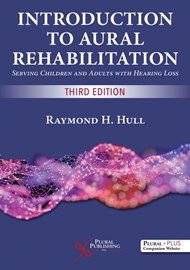As the name indicates, this book deals with the bread and butter of audiologists or at least what should be our bread and butter. We work with changing people in changing environments, therefore, along with an acute understanding of technology, audiologists need to have a level of insight into the ‘human element’ of the job. That’s where this particular text comes in handy. The book is a great introduction to the nature and process of changing people’s lives by helping them hear better.
Given that this is the third edition of the initial text written a couple of decades ago - this material has clearly stood the test of time. The book is designed to be an introductory text for the students of audiology with detailed theoretical principles behind the different approaches of aural rehabilitation proposed in the book. It is really well written, simple and straightforward, which makes the content fairly portable and useful for students of other professions who may want to work with children and adults with hearing needs. This includes students from speech language therapy, psychology, ontology, and specialist teachers in hearing etc.
There are just over 500 pages in the book, with 19 chapters and 16 appendices. The chapters cover mainly four separate themes of aural rehabilitation across the lifespan from children to younger and older adults. There is something for everyone, about everyone. Appendices include a list of very handy questionnaires that can be used in the clinic. At the end of the chapters, there are readymade short answer and multiple answer-type examination papers. No wonder this text has been so popular amongst the teachers! The questions are actually very insightful, and they really test your understanding of the topic in hand. There is a lot of good material on the topic that reflects the author’s grasp of theoretical and practical concepts.
When I picked up this book for this review, I thought it would talk about auditory training in a lot more detail. At least that is what I was wishing for. However, the book has a much wider scope than auditory training, reminding me how long it has been since I was in a formal educational environment. This is where this text fits not in the head of a practising clinician per se. This is for students of a formal course pertaining to some sort of work with children and/or adults with hearing needs.
I have got to admit that, personally, I am not a big fan of the title ‘Aural Rehabilitation’. Notwithstanding the fact that it should really be habilitation and not rehabilitation for children born with hearing issues, the word ‘rehabilitation’ just doesn’t fit into my idea of what is happening through the hearing care process that I provide in my own clinic. Now, I must bow to the prudence of the author here, as he already pre-empted this sort of scepticism and did what sounds like a comprehensive, cross-sectional consultation with students and professionals alike before deciding to stick with this name. That’s fair play, but I am still left wondering if a consultation with the service users may have yielded a different result. After all, this book is ultimately all about the public and not the professionals!
I have been asked to choose a rating on a scale from 1 to 5, with 5 being excellent. All in all, I would give this book 3 out of 5. I suspect that a student of an audiology course who is preparing for their next examination paper in aural rehabilitation, or a professor of audiology teaching this topic, might go slightly higher than that.




